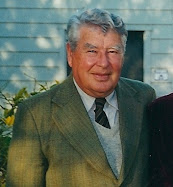By Paul Melody.
In 1868 William made his mark yet again.
In November the previous year (1867) three Irish patriots were executed by hanging in Manchester, England, for their part in a successful attempt to rescue two men charged with being leaders of the Fenian movement - an Irish revolutionary group. News of the execution didn't reach Hokitika until the following February, where it provoked hostile rage among the Irish Catholic community.
The Catholic priest at Waimea, a mining settlement not far from Hokitika, Father William Joseph Larkin, headed a move to hold a mock funeral procession through the streets to honour the executed patriots. William Melody was chosen as one of the two captains to lead the parade.
Writer David McGill in his book "The Lion and the Wolfhound" (1890) said:
"In 1868 a quarter of the 26,000 men on the West Coast goldfields were Irish-born, and 90 per cent of them were Catholic...The 10 per cent of the Irish on the Coast who were Orangemen (member of the Orange Lodge, an anti-Catholic organisation) or Protestants regarded the Catholic majority as a righteous enemy, and vice versa."The procession began to take place on Sunday, March 8, 1868. Author McGill reported:
"Melody of Melody's Hotel acted as marshal, assisted by John Manning (publisher of an Irish Catholic newspaper, "The Celt"), McQuilkin of the Belfast Hotel, and Dooley the cordial manufacturer."A crowd of about 190 set off on a march to Waimea and back. By the time the parade returned to Hokitika the number of marchers had swelled to 750 men, 50 women and up to 30 children.
The footsore contingent arrived in Hokitika headed by Father Larkin and four men carrying a Celtic cross. In spite of the angry shouts among the big crowd of bystanders of "Finians!" and "Blasphemers!" the marchers kept their heads down and marched with solemnity.
The miners wore red Crimean shirts and moleskin trousers tucked into long boots, and were wearing green sashes and green rosettes surrounded by black crepe. Some had green feathers in their American wideawake slouch hats.
Historian McGill said: "Melody and the Waimea storekeeper and goldfield representative James Clarke rode ahead of the procession to the cemetery ... Clarke and Melody dismounted and produced tools. They were asked not to break anything and were shown how by knocking aside a couple of nails they could lift the gate off its hinges. This they duly did.
"The procession moved into the cemetery and to the Roman Catholic portion, where they assembled around a makeshift alter and the Celtic cross. The mourners, estimated at 3000 (with double that in bystanders) knelt. Father Larkin led the burial service in Latin..."
After the funeral oration by Father Larkin, honouring the Manchester martyrs (William Allen, Michael O'Brian and Michael Larkin) the company dispersed. The events of the day aroused outrage among the non-catholic and law-abiding citizens and there was much to-ing and fro-ing among officials determined to make an example of the Hokitika protesters.
The sequel came on March 27 when two policemen went to Melody's Hotel and arrested its proprietor and Father Larkin, while other leading procession figures were arrested elsewhere. The priest was reported as "submissive, but the publican restive."
The mock funeral had been peaceful, there was no violence, and the only damage caused was that inflicted by William Melody on the nails holding the gate to the cemetery. This damage was assessed at 3 shillings (30c). However, the authorities persisted in viewing the events as an outbreak of Fenianism and set out to prosecute the ringleaders.
After an emotional trial at Hokitika the upshot was that Melody and the four other sub-leaders were fined £20 each for organizing an unlawful assembly. But Father Larkin and publisher John Manning were each imprisoned for a month, on charges of seditious libel.
So ended an exciting and memorable chapter in William Melody's life. How long the family of five stayed in Hokitika after the trial is unknown, but they were recorded as living at Half Ounce (Westport) in 1878.
Also in 1878 they lived in Okarito (home of New Zealand's only white heron nesting area), where they made the acquaintance of John Brennan, from County Sligo. As related in the late Patricia French's history of the Melody and Brennan families (elsewhere in this collection), the Melody quintet and Brennan moved to Wanganui between 1878 and 1880, where Brennan married Sarah Melody in 1880.
 It seems likely that William worked for his son-in-law in the pub he established in Wanganui.
It seems likely that William worked for his son-in-law in the pub he established in Wanganui.The curtain rang down on William Melody's colourful life in November 1899, when he was 71.
He went missing during a walk on Castlecliff beach in Wanganui on November 4, and was presumed to have drowned in the Wanganui River. His body was found on the beach near the mouth of the Whangaehu River 15 days later and he was buried at the Wanganui cemetery on November 22, 1899.
His wife, Eliza, had predeceased him when she died at the home of their daughter, Sarah Brennan, at Maxwell on August 7 1891. She was 54.
Sarah Brennan died on February 2, 1913 at New Plymouth and is buried at Wanganui. John Brennan died in 1922.
John Patrick Melody died on June 28, 1942, aged almost 79.
The third child Elizabeth, who married Christopher Brownlie at Wanganui when she was 21, died at Kai Iwi on March 9, 1902, and is buried at the Wanganui Catholic cemetery. She was 36 and was survived by six children.


No comments:
Post a Comment